#1973-74 Serie A
Explore tagged Tumblr posts
Text
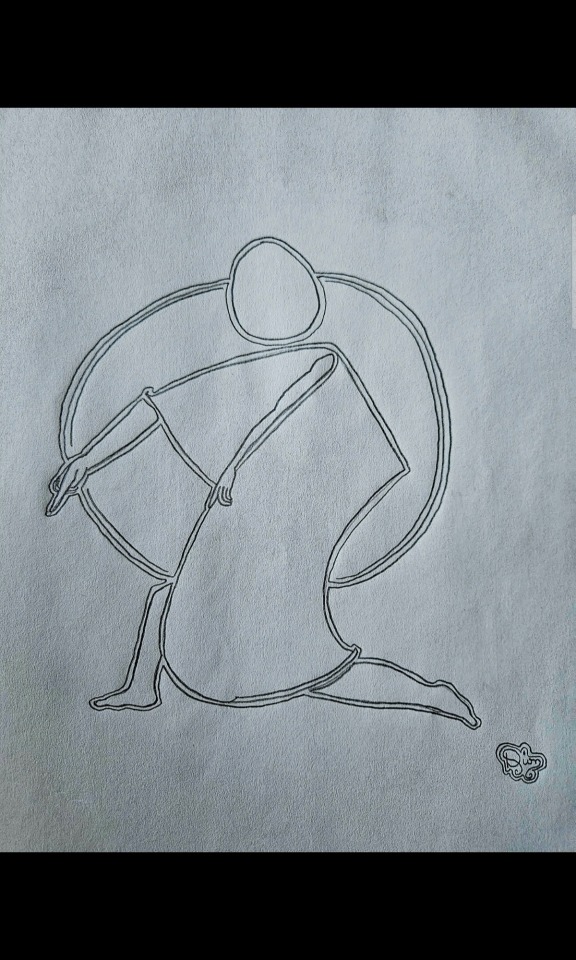
#artists on tumblr#original 1973-74#pencil sketch#titled “7”#I've always liked this#this is the base for everything in the#Septagram Series
4 notes
·
View notes
Text

Marina Abramović Rhythm 5 1974 (published 1994) Gelatin silver print and letterpress panel
The tensions between abandonment and control are at the heart of her series of performances known as Rhythms (1973–74). In Rhythm 5, Abramović lay down inside the blazing frame of a wooden star. With her oxygen supply depleted by the fire, she lost consciousness and had to be rescued by concerned onlookers.
91 notes
·
View notes
Text
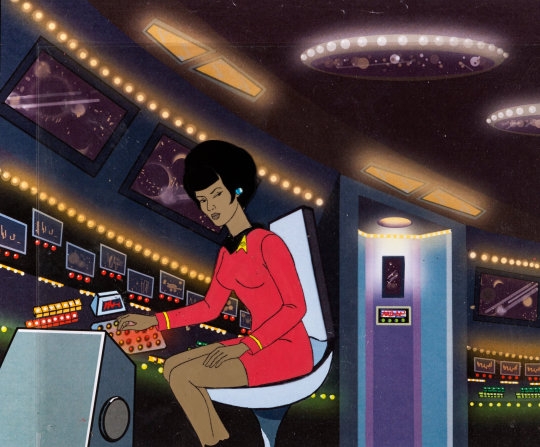
Production art for Star Trek: The Animated Series, 1973/74.
325 notes
·
View notes
Text




Star Trek: The Animated Series, 1973-74. Art director Don Christensen. Animators included Reuben Timmins & Bob Kline
1K notes
·
View notes
Text

Tree: A journey (1973-1974) from the Tree: A journey series 1973-74 John CATO
109 notes
·
View notes
Text


ULAY | S’HE SERIES [1973-74]
143 notes
·
View notes
Text

IT'S FINALLY DONE!!
If you've been following my blog for a bit, you'll know that I have fallen absolutely in love with Kid Eternity. For the last few months, this spreadsheet of all of Kid's appearances (under both Quality and DC Comics) has been my passion project, as I wanted an easy source for his appearances when I wanted to pitch the character to people.
Today, that resource is done, and you can find it right here! On the spreadsheet is a comprehensive list of every single Kid Eternity appearance under Quality Comics (his original company) and DC (minus a few reprints). It also includes an introduction to the character, multiple built in reading lists, content warnings for every issue, and more!
However, if you'd like a quick hits reference guide for Kid, I'll include that here too- under the cut you'll find every comic series where Kid makes a notable appearance in a nice list. Any bullet points that are in bold are ones I consider absolutely essential reading, and the italicized points are my personal favorites. Please look at the spreadsheet too, though. I spent a lot of time on it. Also, I'll be updating the spreadsheet regularly but not this post, probably, so the spreadsheet will be your best resource for future content.
QUICK HITS READING LIST:
Hit Comics (1940), Issues #25-60
Kid Eternity Vol. 1 (1946), Issues #1-18
Secret Origins Vol. 2 (1973), Issue #4
Shazam! (1973), Issue #27
World's Finest Comics (1941), Issues #268, #279-282
Adventure Comics (1938), Issues #491-492
Kid Eternity Vol. 2 (1991), Issues #1-3
Kid Eternity Vol. 3 (1993), Issues #1-16
Vertigo Jam (1993), Issue #1
JSA Vol. 1 (1999), Issues, #1, #47-48
Teen Titans Vol. 3 (2003), Issues #31, #67-74, #92
Teen Titans Annual Vol. 3 (2009), Issue #2
Titans Vol. 2 (2008), Issue #13
Vigilante Vol. 3 (2009), Issues #5-6
National Comics: Eternity (2012), Issue #1
Batman: Urban Legends (2021), Issues #11-13
JSA Vol. 2 (2024), Issue #3
#kid eternity#dc comics#SHE IS COMPLETE!!! and she WILL become my pinned post i am proud of my work#and i want to show off my daughter (am i talking about kid or the spreadsheet. who knows.)#jsa 2024#(including that tag in case anyone reading that comic is looking for some context for this kid)
18 notes
·
View notes
Photo

TV Guide - February 8 - 14, 1964
Beatrice Benaderet (/ˌbɛnəˈdɛrət/ ben-ə-DERR-ət; April 4, 1906 – October 13, 1968) Actress and comedienne.
Benaderet was a prominent figure on television in situation comedies, first with The George Burns and Gracie Allen Show from 1950 to 1958, for which she earned two Emmy Award nominations for Best Supporting Actress. In the 1960s, she had regular roles in four series until her death from lung cancer in 1968, including the commercial successes The Beverly Hillbillies, The Flintstones, and her best-known role as Kate Bradley in Petticoat Junction. (Wikipedia)
Linda Kaye Henning (born September 16, 1944) Actress and singer most notable for starring in the 1960s sitcom Petticoat Junction. (Wikipedia)
Patricia Joy “Pat” Woodell (July 12, 1944 – September 29, 2015) Actress and singer, best known for her television role as Bobbie Jo Bradley from 1963 to 1965 on Petticoat Junction. (Wikipedia)
Jeannine Brooke Riley (born October 1, 1940) Film and television actress.
Winning the role over 300 competitors, Riley portrayed Billie Jo Bradley on the first two seasons of the CBS sitcom Petticoat Junction (1963–1965). Riley left the series in 1965 to pursue movies. She also had a regular cast member role on the comedy variety series Hee Haw (1969–1971). She played Lulu McQueen (a take-off on Ginger Grant, played by Tina Louise, from Gilligan's Island) on the western sitcom Dusty's Trail, which aired in 1973–74. (Wikipedia)
21 notes
·
View notes
Text

Born a photographer March 29, 1944. Abbas Attar was an Iranian transplanted to Paris. He dedicated himself to documenting the political and social life of societies in conflict. In a career that spanned six decades, he covered wars and revolutions in Biafra, Bangladesh, Northern Ireland, Vietnam, the Middle East, Chile, Cuba, and South Africa during apartheid. He also documented life in Mexico over several years, and pursued a lifelong interest in religion and its intersection with society.
From 1978 to 1980, Abbas photographed the revolution in Iran, to which he returned in 1997 after seventeen years of voluntary exile. His book Iran Diary 1971-2002 is a critical interpretation of Iranian history, photographed and written as a private journal.
During his years of exile Abbas traveled constantly. Between 1983 and 1986 he journeyed through Mexico, attempting to photograph a country as a novelist might write about it. The resulting exhibition and book, Return to Mexico: Journeys Beyond the Mask, helped define his photographic aesthetic.
From 1987 to 1994, he focused on the growth of Islamism throughout the world. Allah O Akbar: A Journey Through Militant Islam, the subsequent book and exhibition, spanning twenty-nine countries and four continents, attracted special attention after the 9/11 attacks by Islamic jihadists. A later book, Faces of Christianity: A Photographic Journey (2000), and touring show, explored Christianity as a political, ritual and spiritual phenomenon.
Abbas’s concern with religion led him in 2000 to begin a project on animism, in which he sought to discover why non-rational ritual had re-emerged in a world increasingly defined by science and technology. He abandoned this undertaking in 2002, on the first anniversary of 9/11, to start a new long-term project about the clash of religions, defined as a culture rather than faith, which he believed are turning into political ideologies and therefore one of the sources of the strategic struggles of the contemporary world.
From 2008 to 2010 Abbas travelled the world of Buddhism, photographing with the same skeptical eye. In 2013, he concluded a similar long-term project on Hinduism.
Most recently before his death, Abbas was working on documenting Judaism around the world.
A member of Sipa from 1971 to 1973, then of Gamma from 1974 to 1980, Abbas joined Magnum Photos in 1981 and became a member in 1985.
On Wednesday April 25, 2018 the Iranian photographer Abbas Attar known simply as Abbas, died in Paris, aged 74.
According to Abbas, in a 2017 interview with Magnum, there are two photographic methods: “One is writing with light,” he said, “and the other is drawing with light.” While he viewed other Magnum photographers like Henri Cartier-Bresson as adherents of the latter, the former was the foundation of Abbas’ practice. In lieu of placing his focus on single moments in time, he looked at his photographs as interlinked elements of a greater whole. In this sense, Abbas was a storyteller, and his images were pages of tales on celluloid, which were no less arresting when viewed (or rather, read) in isolation.
In the same interview, Abbas noted that it was a 1968 trip to New Orleans that made him understand the importance of what he called “sequencing”, or creating a narrative thread through a series of images. Examples of this can be seen in Abbas’s book Return to Mexico: Journey Beyond the Mask (1992), a document of his travels through the country in the 1980s.
His books aside, Abbas’ work has been the subject of exhibitions in galleries and museums around the world, including the Tehran Museum of Contemporary Art, the National Museum of Singapore, Galerie FNAC and the Magnum Gallery in Paris, and the Grey Art Gallery at New York University.
“It is with immense sadness that we lose him,” Dworzak said. “May the gods and angels of all the world’s major religions he photographed so passionately be there for him.”
Daily inspiration. Discover more photos at Just for Books…?
13 notes
·
View notes
Text

Batman and Manhunter (Paul Kirk) by Walt Simonson.
This version of Manhunter has a rather confusing history. Originally, Paul Kirk was a private investigator, created by Ed Moore, who starred in his own serial in Adventure Comics (vol. 1) starting with issue #58 (January, 1941). The feature was titled Paul Kirk, Manhunter, but that was just a description of the job he did, not a nickname he used, nor was he ever called that.
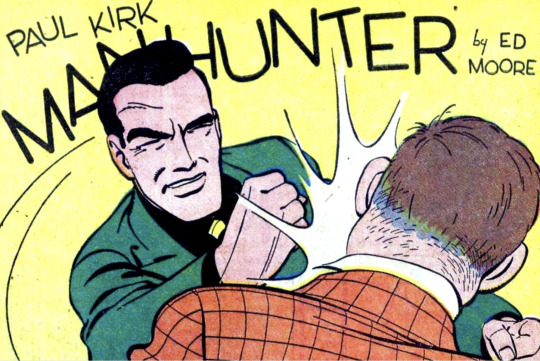
The Paul Kirk, Manhunter feature ended in issue #72.
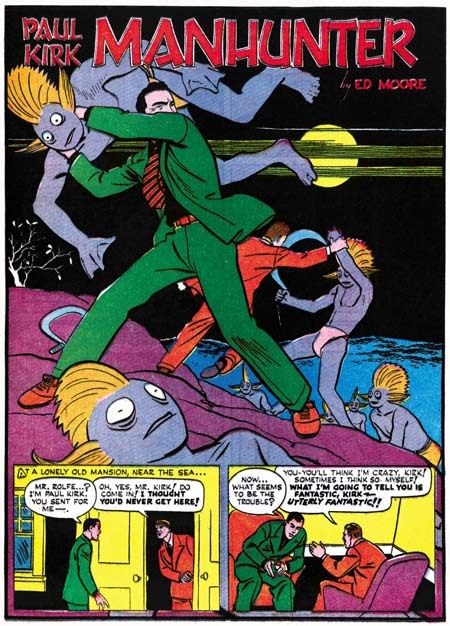
The final appearance of Paul Kirk, Manhunter, from Adventure Comics #72.
Adventure Comics #73, April 1942)* saw the debut of a new, costumed Manhunter feature by Joe Simon and Jack Kirby.
The new Manhunter was Rick Nelson (no, not Ozzie and Harriet's kid), a former big game hunter who decided he should put his skills to use hunting down criminals. He donned a costume and began his career as a crimefighter.

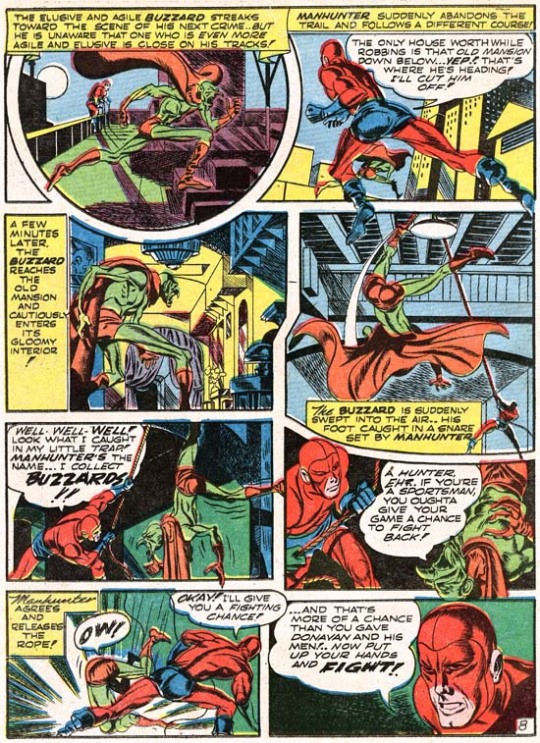
The cover of Adventure Comics #73, the new Manhunter's first appearance, and page 8 from his initial story. Obviously, no one at DC editorial knew that Manhunter had a blue face mask, which is why the colorist went out of his way to create a mask for the character.
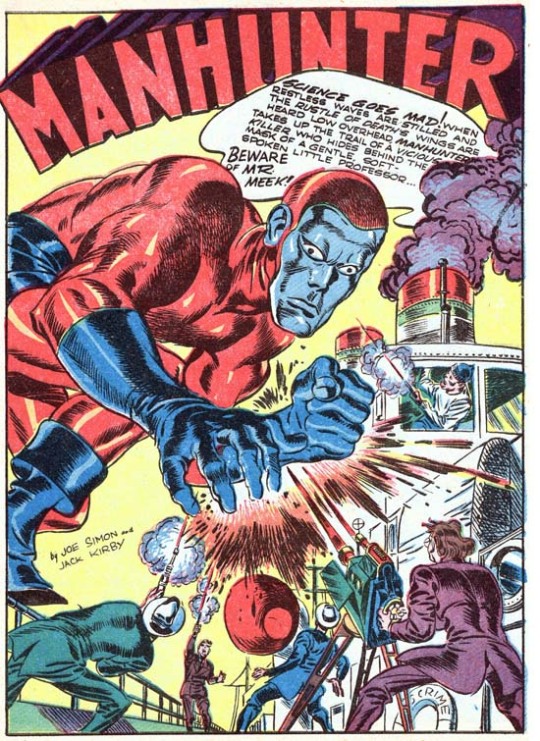
Adventure Comics #75, wherein everyone is finally on the same page about the mask, except now his ear is blue as well.
As you can tell from these images, the new Manhunter definitely was in no way related to the previous feature with Paul Kirk.
Except by his second appearance in Adventure Comics #74 the character's name was changed from Rick Nelson to Paul Kirk. I don't know why made that decision, although many sources point the finger at DC's editorial staff. Anyhow, that led to the original Paul Kirk getting completely retconned out of DC continuity.
Simon and Kirby left the Manhunter feature after Adventure Comics #80 (November, 1942), although they were still doing the Sandman feature in that book. Manhunter's final appearance was in Adventure Comics #92 (June, 1944).
Writer/editor Archie Goodwin and artist Walt Simonson revived the Manhunter character for a series of 8-page back-up stories in Detective Comics (vol. 1) #473 (November, 1973).
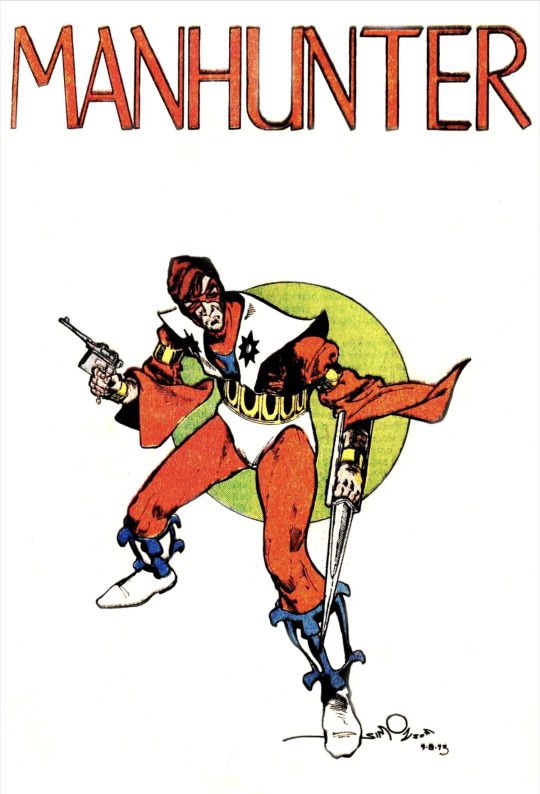
The new Manhunter by Walt Simonson. The figure is from a DC house ad.
This new Manhunter was a revived and revised Paul Kirk. Kirk had given up the costumed crimefighter gig and returned to big game hunting. He was mortally wounded during a hunt, and that would have been the end of him. But an organization called the Council found him, used their super-science to heal him, and gave him a genetic enhancement that gave him advanced healing. They also cloned him enough times to create a small army, of which Kirk was leader.
Goodwin and Simonson were going to make their Manhunter a completely original character. However, they used Simon and Kirby's version of Paul Kirk so that they did not have to spend their limited comic book pages to create a back story for their hero.
Kirk eventually realized the Council was up to no good and began working to take the organization down. He gained some allies along the way, including Batman. Together they brought an end to the Council, although Kirk lost his life - for good this time - when he caused the Council's HQ to explode.
Jack Kirby tried to revive his Joe Simon's version of Manhunter in 1st Issue Special #5 (August, 1975).
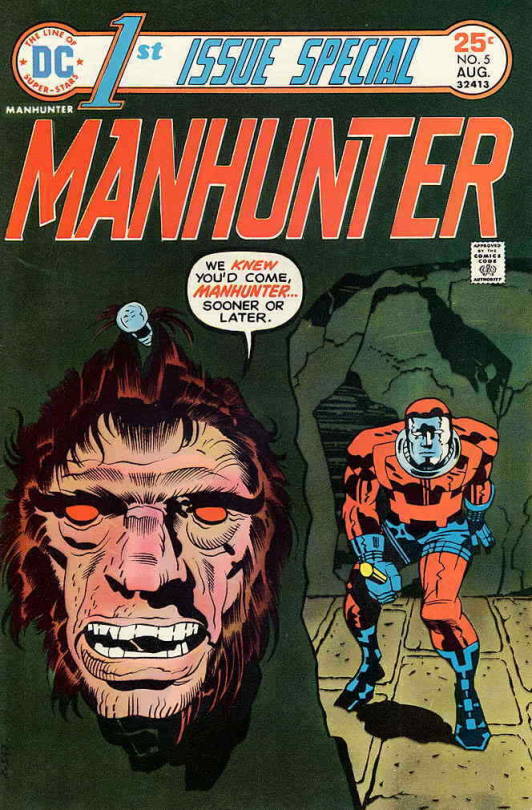
The main character was Mark Shaw, not Paul Kirk, but the costumes were very similar. Jack also established an ancient organization that picked worthy individuals to act as a Manhunter to take down the criminals and gangs that the police could not - or would not - touch.
Unfortunately, Jack never got to finish that story. Instead, Steve Englehart took the concept and ran with it in a totally different direction during his brief tenure as the writer on Justice League of America.
That was not the end of the Manhunter character, of course, which has been revived several more times (including twice by surviving clones of Kirk). But that's a post for another day.
(* In March, 1942, one month before Simon and Kirby's Manhunter debuted, Quality Comics introduced their own Manhunter in Police Comics #8.
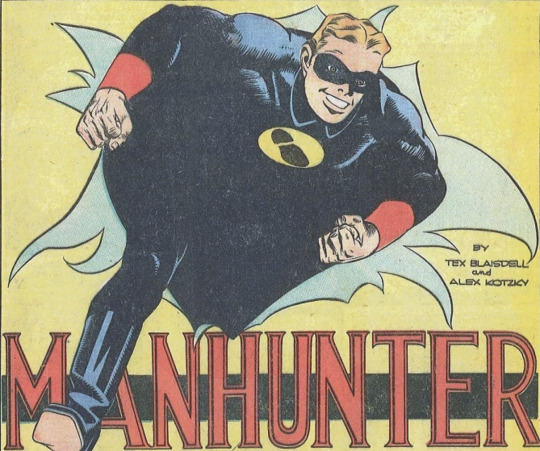
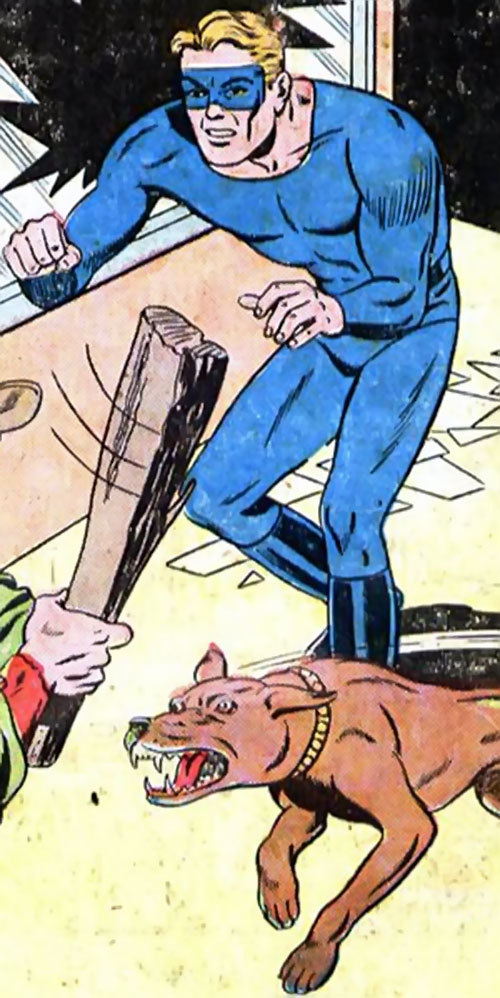
This guy was Dan Richards, a police rookie who graduated at the bottom of his academy class. A friend of his got framed, so Richards donned a rather dull costume (sometimes without pants, and the footprint chest emblem didn't last long) to fight crime. He was assisted by his faithful dog, Thor.
This Manhunter outlasted DC's version by a good stretch, until August, 1950's Police Comics #101.
Shortly thereafter, DC bought all of Quality's characters. Eventually all of them were incorporated into the DC Universe. The two different Manhunters finally met, post-Crisis On Infinite Earths, in All-Star Squadron #31.)
#Batman#Manhunter#Paul Kirk Manhunter#Rick Nelson#Dan Richards#Thor the dog#DC Comics#Quality Comics#Golden Age Comics#Ed Moore#Joe Simon#Jack Kirby#Tex Blaisdell#Alex Kotsky
29 notes
·
View notes
Text
Kaiju Week in Review (June 18-24, 2023)
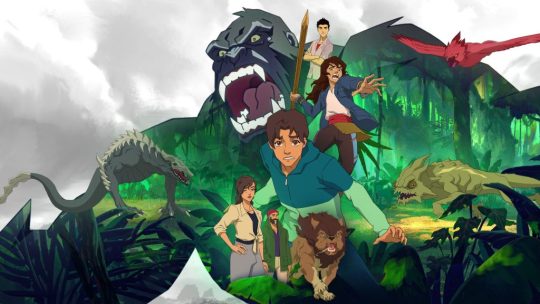
The big news of the week, of course, was Netflix finally releasing Skull Island, the first new Monsterverse story in over two years. It's a surprisingly standalone piece, with no Monarch and minimal references to Kong: Skull Island, and going off his Twitter, creator Brian Duffield largely prefers to let the work speak for itself. I have quibbles with some of the creature designs—not enough florafauna!—and the characters can be too flippant about their life-threatening circumstances, but overall I had a good time. Annie's a great character—think Saeko from Son of Godzilla as a bloodthirsty teenager—and the obligatory Titan nemesis is a cut above most of the Monsterverse's original creatures.
As for its future, Season 2 is already written and recorded, but won't happen unless Netflix sees big enough viewing numbers for Season 1. I'm frustrated by that, especially given how many loose ends the season finale had, but it's pretty typical stuff from the company.

Dismal news about the American Shin Ultraman Blu-ray/DVD from Cleopatra Entertainment: they didn't bother to include translations for the ample on-screen Japanese text. That was enough for me to cancel my preorder; I tend to be pretty tolerant of the various unforced errors by the companies releasing this stuff, but that level of laziness (the translations already exist!) just renders the discs pointless in my eyes.

Toho is crowdfunding another Showa suit replica for a character's 50th anniversary this year... Jet Jaguar! If successful (or semi-successful, like last year's Gigan campaign), it'll feature in a new short film to premiere on November 3, as has been tradition since 2020. Interesting that they went for Jet Jaguar over Megalon; I suppose he'd be cheaper to produce, and the largest film studio in Japan seems hellbent on hamstringing these wonderful little shorts.

Godzilla: Here There Be Dragons #1 is out. Hard to judge it so far as it's mostly setup.

In other news related to Godzilla vs. Megalon's 50th, Bandai will release a Movie Monster Series figure of the 1973 Godzilla (MegaroGoji) on July 28 as a Godzilla Store exclusive. Pretty big news, as they've only released figures of the tweaked '74 and '75 suits previously, and those were back in 2003 and 2004, respectively. NECA didn't get to this one either.
#kaiju week in review#godzilla vs. megalon#godzilla#jet jaguar#skull island#king kong#godzilla here there be monsters#shin ultraman
43 notes
·
View notes
Text
Columbo: Season 3 (1973-74)
This is a pretty solid season that continues the series' overall consistency. The stories move at a good pace and play with the typical murder mystery format of the series in clever ways. The series keeps many of its core elements but they are often presented in refined and exciting new directions. Columbo is given some added character depths here, which allows for some of Peter Falk's best bits in the series thus far, and the guest characters are given some nice variety. The guest actors continue to shine here with some iconic figures used in unexpected ways. The direction plays with the series' style while letting each episode stand out in their set pieces. The visuals make great use of the settings while having distinct moments for each episode. This is a fun season that matches the previous seasons and in some episodes surpasses them.
Episodes Ranked:
8.Candidate for Crime

7.Mind Over Mayhem

6.Publish or Perish

5.Double Exposure

4.A Friend in Deed

3.Swan Song

2.Lovely But Lethal

1.Any Old Port in a Storm

#columbo#tv movies#series#1973#1974#jeannot szwarc#leo penn#boris sagal#richard quine#robert butler#alf kjellin#nicholas colasanto#ben gazzara#first time watch
5 notes
·
View notes
Text

Castle in the Sky (1986) was photographed by Hirokata Takahashi. Hiro has 50 cinematography credits from 1957, his second credit, 47 episodes of a 1973-74 animated series, to 2003. None of his other credits have any international recognition.
2 notes
·
View notes
Text

Production art for Star Trek: The Animated Series, 1973/74.
256 notes
·
View notes
Text

Stewart Byron “Stu” Gilliam (July 27, 1933 – October 11, 2013) was an actor stand-up, and TV comedian.
He was born in a middle-class area of Detroit, the grandson of a church minister. He left home at the age of 14 to perform with a circus as a ventriloquist in state fairs, then after a few years began to appear in clubs in Chicago. During his two-year service in the Korean War, he entertained troops as a ventriloquist. In the 1950s/60s he performed his act in clubs nationwide with black audiences, including the Apollo Theater in New York City. He sometimes performed for mixed-race shows, but in Southern states was prevented from appearing onstage at the same time as white performers. Finally, the Playboy Club circuit placed him before largely white crowds, including in the South.
He appeared on national television in the 1960s, including The Ed Sullivan Show, Playboy After Dark, and The Dean Martin Show. He did stand-up work and TV and film appearances in the 1960s and 1970s. In 1968, he was paired with Don Adams and Robert Culp in Get Smart as Agent Samuels in “Die, Spy”, a spoof of the television series I Spy. He was the voice of Freddie “Curly” Neal on the cartoon series Harlem Globetrotters in the early seventies.
He co-starred in Roll Out (1973-74) season. The series was set in France during WWII and was loosely based on the 1952 film Red Ball Express. He married Vivian Baraville (2007). #africanhistory365 #africanexcellence
3 notes
·
View notes
Text

Tree: A journey (1973-1974) from the Tree: A journey series 1973-74 John CATO
31 notes
·
View notes